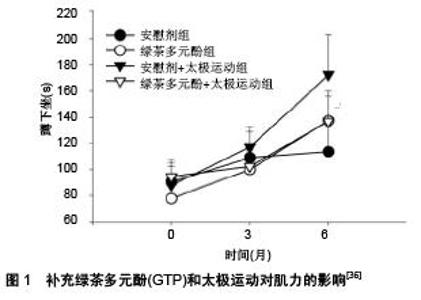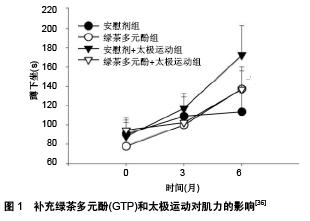Chinese Journal of Tissue Engineering Research ›› 2015, Vol. 19 ›› Issue (51): 8317-8321.doi: 10.3969/j.issn.2095-4344.2015.51.021
Previous Articles Next Articles
Effects of T’ai Chi on bone density and bone turnover markers
Zhang Ling-li, Wu Wei, Yu Zhu-sheng
- Shanghai University of Sport, Shanghai 200438, China
-
Received:2015-09-24Online:2015-12-10Published:2015-12-10 -
Contact:Yu Zhu-sheng, Professor, Shanghai University of Sport, Shanghai 200438, China -
About author:Zhang Ling-li, Studying for doctorate, Shanghai University of Sport, Shanghai 200438, China -
Supported by:a grant from Shanghai Key Laboratory for Development and Protection of Human Exercise Capacity (Shanghai University of Sport), No. 11DZ2261100
CLC Number:
Cite this article
Zhang Ling-li, Wu Wei, Yu Zhu-sheng. Effects of T’ai Chi on bone density and bone turnover markers[J]. Chinese Journal of Tissue Engineering Research, 2015, 19(51): 8317-8321.
share this article
| [1] 晏利姣,郝玉芳.运用Endnote和Refviz文献分析软件对太极拳相关英文文献的分析[J].中国运动医学杂志,2013,32(7):629-632.
[2] 孔祥华,刘小平.太极拳概念的界定[J].体育学刊,2009,16(7): 102-104.
[3] 吴松,太极拳对老年人的健身功效研究述评[J].搏击•武术科学, 2006,3(1):39-42.
[4] 王雪芹,太极拳的生理医学效应研究进展[J].中国体育科技, 2011,47(4):113-120.
[5] 崔巴特尔,王卓涛,李立,等.太极拳运动对老年人身心健康影响的研究进展[J].中国老年学杂志,2011,31(9):1716-1718.
[6] 楼文赞.太极拳锻炼对人体作用的研究[J].南京体育学院学报, 2003, 17(6):170-171.
[7] 赵凤娟,颜波.浅析太极拳的健身功能[J].搏击武术科学,2010,7(3): 40-41.
[8] Kelly GA, Kelly KS, Tran ZV. Resistance training and bone mineral density in women:a meta analysis of controlled trials. Am J Phys Med Rehabil.2001;80(1):65-77.
[9] 金续忠,沙海燕.运动与骨密度的研究进展[J].安徽体育科技, 2003, 24(4):50-53.
[10] Elaine MM.Designing exercise programs to lower fracture risk in mature women. Strength Conditioning J.2006; (1):24-30.
[11] Mayhew PM, Thomas CD, Clement JG, et al. Relation between age, femoral neck cortical stability, and hip fracture risk. Lancet. 2005;9480:129-136.
[12] 张静文,杨扬,唐宏亮.太极拳干预社区中老年人亚健康状态的临床随机对照试验[J].南京体育学院学报:自然科学版,2011, 10(6):18-20.
[13] 李建国.老年健身太极拳运动强度探析[J].科技信息,2013, (21): 174.
[14] Lui PP, Qin L, Chan KM. Tai Chi Chuan exercises in enhancing bone mineral density in active seniors. Clin Sports Med. 2008; 27(1):75-86, viii.
[15] Yoshimura N, Hashimoto T, Morioka S, et al. Determinants of bone loss in a rural Japanese community: the Taiji Study. Osteoporos Int. 1998;8(6):604-610.
[16] Yoshimura N, Kasamatsu T, Sakata K, et al. The relationship between endogenous estrogen, sex hormone-binding globulin, and bone loss in female residents of a rural Japanese community: the Taiji Study. J Bone Miner Metab. 2002;20(5):303-310.
[17] Yoshimura N, Muraki S, Oka H, et al. Capacity of endogenous sex steroids to predict bone loss in Japanese men: 10-year follow-up of the Taiji Cohort Study. J Bone Miner Metab. 2011; 29(1):96-102.
[18] 王忠山.习太极拳老人骨健康状况的多年追踪研究[J].体育科学, 2000;20(1):79-81.
[19] 杜新星,张明军,苟波,等.太极柔力球运动对围绝经期女性雌激素及骨代谢指标的影响[J].西安体育学院学报,2014,31(4):459-463.
[20] Qin L, Choy W, Leung K, et al. Beneficial effects of regular Tai Chi exercise on musculoskeletal system. J Bone Miner Metab. 2005;23(2):186-190.
[21] 高元元,王志鹏,刘晓军.长期习练太极拳对老年女性骨健康状况与骨代谢的影响[J].北京体育大学学报,2010,33(9):60-62.
[22] 刘长江,刘刚.规律性太极拳锻炼对退休知识女性血脂、瘦素水平及骨密度的影响[J].辽宁体育科技,2014,36(3):55-58.
[23] Woo J, Hong A, Lau E, et al. A randomised controlled trial of Tai Chi and resistance exercise on bone health, muscle strength and balance in community-living elderly people. Age Ageing. 2007,36(3):262-268.
[24] 龚敏,张素珍,王斌,等.长期太极拳练习对老年人骨密度的影响[J].中国临床康复,2003,7(15):2238-2239.
[25] 周勇.传统体育对绝经女性骨密度的影响[J].北京体育大学学报, 2004,27(3):354-360.
[26] 周勇,李靖,陈冰,等.太极推手锻炼与补钙对绝经女性骨密度的影响[J].中国运动医学杂志,2005,24(1):106-108.
[27] Wayne PM, Kiel DP, Krebs DE, et al. The effects of Tai Chi on bone mineral density in postmenopausal women: a systematic review. Arch Phys Med Rehabil. 2007;88(5):673-680.
[28] 楼华.老年性骨质疏松及其运动疗法的干预[J].中国组织工程研究与临床康复,2007,11(52):10671-10674.
[29] Schmitt NM, Schmitt J, Dören M.The role of physical activity in the prevention of osteoporosis in postmenopausal women-An update.Maturitas. 2009;63(1):34-38.
[30] 宋桦.太极拳锻炼对原发性骨质疏松症患者骨密度及骨代谢的影响[J].体育学 刊,2008,15(15):106-108.
[31] Chang TJ, Ting YT, Sheu SL, et al. Effects of tai chi in postmenopausal women with osteoporosis: a systematic review. Hu Li Za Zhi. 2014;61(5):75-84.
[32] Yoshimura N, Muraki S, Oka H, et al. Biochemical markers of bone turnover as predictors of osteoporosis and osteoporotic fractures in men and women: 10-year follow-up of the Taiji cohort.Mod Rheumatol. 2011;21(6):608-620.
[33] 许爱萍.骨代谢标志物与绝经后妇女骨质疏松症的相关性研究[J].检验医学与临床,2009,6(24):2109-2110.
[34] 张玲莉,陈炳霖,邹军.运动影响骨转换:促进或抑制骨细胞/破骨细胞的发育和活性[J].中国组织工程研究,2014,18(42):6838-6843.
[35] Yoshimura N, Muraki S, Oka H, et al.Changes in serum levels of biochemical markers of bone turnover during 10 years among Japanese men and women: associated factors and birth-cohort effect. The Taiji Study.J Bone Miner Metab. 2011;29(6):699-708.
[36] Shen CL, Chyu MC, Yeh JK, et al. Effect of green tea and Tai Chi on bone health in postmenopausal osteopenic women: a 6-month randomized placebo-controlled trial.Osteoporos Int. 2012;23(5):1541-1552.
[37] Shen CL, Chyu MC, Yeh JK, et al. Green tea polyphenols and Tai Chi for bone health: Designing a placebo-controlled randomized trial.BMC Musculoskelet Disord.2009;10:110.
[38] Shen CL, Chyu MC, Pence BC,et al. Green tea polyphenols supplementation and TaiChi exercise for postmenopausal osteopenic women: safety and quality of life report. BMC Complement Altern Med.2010;10:76.
[39] Clowes JA, Hannon RA, Yap TS, et al. Effect of feeding on bone turnover markers and its impact on biological variability of measurements.Bone.2002;30(6):886-890.
[40] Koivula MK, Risteli L, Risteli J. Measurement of aminoterminal propeptide of type I procollagen(PINP) in serum. Clinical biochemistry.2012;45(12):920-927.
[41] Hern ández MV, Guaabens N, Alvarez L, et al. Immunocytochemical evidence on the effects of glucocorticoids on type I collagen synthesis in human osteoblastic cells.Calcified tissue international.2004;74(3):284-293.
[42] Mendoza-Núñez VM, Hernández-Monjaraz B, Santiago-Osorio E, et al. Tai Chi exercise increases SOD activity and total antioxidant status in saliva and is linked to an improvement of periodontal disease in the elderly. Oxid Med Cell Longev. 2014,2014:603853.
[43] Ho TJ, Ho LI, Hsueh KW, et al. Tai Chi intervention increases progenitor CD34(+) cells in young adults. Cell Transplant. 2014, 23(4-5):613-620.
[44] 肖扬,王万春.细胞因子与骨质疏松症[J].中国临床康复, 2006, 10(32): 126-129.
[45] 董莲萍,陈澍.老年糖尿病患者骨密度及骨代谢相关因素的探讨[J].中国老年学杂志,2001,21(1):30-31.
[46] 梁君慧,巩志勇,赵冰,等.绝经后妇女骨密度改变与血清激素水平变化[J].中国骨质疏松杂志,2000,6(1):65-68.
[47] Qian G, Xue K, Tang L, et al. Mitigation of oxidative damage by green tea polyphenols and Tai Chi exercise in postmenopausal women with osteopenia.PLoS One. 2012;7(10):e48090.
[48] Jahnke R, Larkey L, Rogers C, et al. A comprehensive review of health benefits of qigong and tai chi. Am J Health Promot. 2010; 24(6):e1-e25. |
| [1] | Chen Ziyang, Pu Rui, Deng Shuang, Yuan Lingyan. Regulatory effect of exosomes on exercise-mediated insulin resistance diseases [J]. Chinese Journal of Tissue Engineering Research, 2021, 25(25): 4089-4094. |
| [2] | Chen Yang, Huang Denggao, Gao Yuanhui, Wang Shunlan, Cao Hui, Zheng Linlin, He Haowei, Luo Siqin, Xiao Jingchuan, Zhang Yingai, Zhang Shufang. Low-intensity pulsed ultrasound promotes the proliferation and adhesion of human adipose-derived mesenchymal stem cells [J]. Chinese Journal of Tissue Engineering Research, 2021, 25(25): 3949-3955. |
| [3] | Yang Junhui, Luo Jinli, Yuan Xiaoping. Effects of human growth hormone on proliferation and osteogenic differentiation of human periodontal ligament stem cells [J]. Chinese Journal of Tissue Engineering Research, 2021, 25(25): 3956-3961. |
| [4] | Sun Jianwei, Yang Xinming, Zhang Ying. Effect of montelukast combined with bone marrow mesenchymal stem cell transplantation on spinal cord injury in rat models [J]. Chinese Journal of Tissue Engineering Research, 2021, 25(25): 3962-3969. |
| [5] | Gao Shan, Huang Dongjing, Hong Haiman, Jia Jingqiao, Meng Fei. Comparison on the curative effect of human placenta-derived mesenchymal stem cells and induced islet-like cells in gestational diabetes mellitus rats [J]. Chinese Journal of Tissue Engineering Research, 2021, 25(25): 3981-3987. |
| [6] | Hao Xiaona, Zhang Yingjie, Li Yuyun, Xu Tao. Bone marrow mesenchymal stem cells overexpressing prolyl oligopeptidase on the repair of liver fibrosis in rat models [J]. Chinese Journal of Tissue Engineering Research, 2021, 25(25): 3988-3993. |
| [7] | Liu Jianyou, Jia Zhongwei, Niu Jiawei, Cao Xinjie, Zhang Dong, Wei Jie. A new method for measuring the anteversion angle of the femoral neck by constructing the three-dimensional digital model of the femur [J]. Chinese Journal of Tissue Engineering Research, 2021, 25(24): 3779-3783. |
| [8] | Meng Lingjie, Qian Hui, Sheng Xiaolei, Lu Jianfeng, Huang Jianping, Qi Liangang, Liu Zongbao. Application of three-dimensional printing technology combined with bone cement in minimally invasive treatment of the collapsed Sanders III type of calcaneal fractures [J]. Chinese Journal of Tissue Engineering Research, 2021, 25(24): 3784-3789. |
| [9] | Qian Xuankun, Huang Hefei, Wu Chengcong, Liu Keting, Ou Hua, Zhang Jinpeng, Ren Jing, Wan Jianshan. Computer-assisted navigation combined with minimally invasive transforaminal lumbar interbody fusion for lumbar spondylolisthesis [J]. Chinese Journal of Tissue Engineering Research, 2021, 25(24): 3790-3795. |
| [10] | Hu Jing, Xiang Yang, Ye Chuan, Han Ziji. Three-dimensional printing assisted screw placement and freehand pedicle screw fixation in the treatment of thoracolumbar fractures: 1-year follow-up [J]. Chinese Journal of Tissue Engineering Research, 2021, 25(24): 3804-3809. |
| [11] | Shu Qihang, Liao Yijia, Xue Jingbo, Yan Yiguo, Wang Cheng. Three-dimensional finite element analysis of a new three-dimensional printed porous fusion cage for cervical vertebra [J]. Chinese Journal of Tissue Engineering Research, 2021, 25(24): 3810-3815. |
| [12] | Wang Yihan, Li Yang, Zhang Ling, Zhang Rui, Xu Ruida, Han Xiaofeng, Cheng Guangqi, Wang Weil. Application of three-dimensional visualization technology for digital orthopedics in the reduction and fixation of intertrochanteric fracture [J]. Chinese Journal of Tissue Engineering Research, 2021, 25(24): 3816-3820. |
| [13] | Sun Maji, Wang Qiuan, Zhang Xingchen, Guo Chong, Yuan Feng, Guo Kaijin. Development and biomechanical analysis of a new anterior cervical pedicle screw fixation system [J]. Chinese Journal of Tissue Engineering Research, 2021, 25(24): 3821-3825. |
| [14] | Lin Wang, Wang Yingying, Guo Weizhong, Yuan Cuihua, Xu Shenggui, Zhang Shenshen, Lin Chengshou. Adopting expanded lateral approach to enhance the mechanical stability and knee function for treating posterolateral column fracture of tibial plateau [J]. Chinese Journal of Tissue Engineering Research, 2021, 25(24): 3826-3827. |
| [15] | Zhu Yun, Chen Yu, Qiu Hao, Liu Dun, Jin Guorong, Chen Shimou, Weng Zheng. Finite element analysis for treatment of osteoporotic femoral fracture with far cortical locking screw [J]. Chinese Journal of Tissue Engineering Research, 2021, 25(24): 3832-3837. |
| Viewed | ||||||
|
Full text |
|
|||||
|
Abstract |
|
|||||

